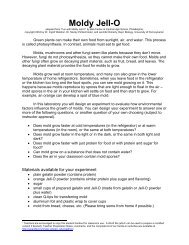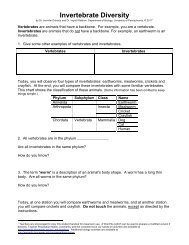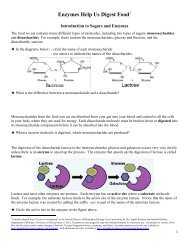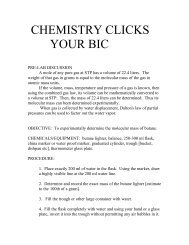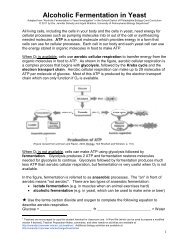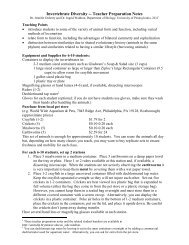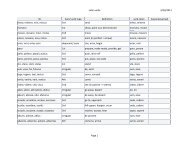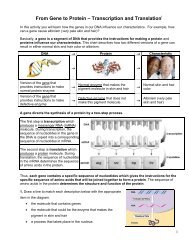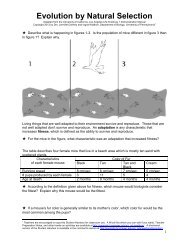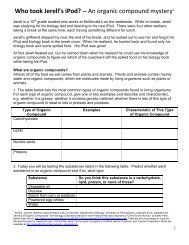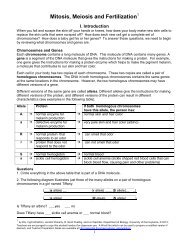From Gene to Protein -- Transcription and Translation ... - Serendip
From Gene to Protein -- Transcription and Translation ... - Serendip
From Gene to Protein -- Transcription and Translation ... - Serendip
You also want an ePaper? Increase the reach of your titles
YUMPU automatically turns print PDFs into web optimized ePapers that Google loves.
(from Krogh, Biology: a Guide <strong>to</strong> the Natural World)<br />
The bonds within each str<strong>and</strong> are covalent bonds. In contrast, base pairing involves weaker hydrogen<br />
bonds which are more readily broken as occurs during transcription <strong>and</strong> translation. During<br />
transcription, multiple different nucleotides enter <strong>and</strong> leave the RNA polymerase, but, for each DNA<br />
nucleotide only the complementary RNA nucleotide that has the right shape <strong>and</strong> charges <strong>to</strong> form<br />
multiple hydrogen bonds with that specific DNA nucleotide will remain in place <strong>to</strong> be covalently<br />
bonded <strong>to</strong> the preceding RNA nucleotide.<br />
The enzyme that binds each tRNA <strong>to</strong> the appropriate amino acid forms a covalent bond between the<br />
tRNA <strong>and</strong> amino acid. 4 Inside the ribosome there is a ribozyme (RNA enzyme) that simultaneously<br />
breaks this covalent bond <strong>and</strong> forms a new covalent peptide bond between this amino acid <strong>and</strong> the<br />
previous amino acid in the growing polypeptide chain; thus, this ribozyme, transfers the amino acid<br />
from the tRNA <strong>to</strong> the growing polypeptide chain. Ribosomes have three sites for tRNAs, including the<br />
sites we have shown in our model ribosome <strong>and</strong> a third site (<strong>to</strong> the left) where the tRNA that has lost<br />
its amino acid is located before it exits the ribosome.<br />
There are 40-45 different types of tRNA, with some types of tRNA able <strong>to</strong> match with two different<br />
codons that have the same first two nucleotides but differ in the third nucleotide (both are codons for<br />
the same amino acid). Some students have difficulty underst<strong>and</strong>ing the function of the tRNA<br />
molecule. An analogy that may help them underst<strong>and</strong> is as follows. Suppose a group of American<br />
4 A simulation of this enzyme in action is available at<br />
http://www.phschool.com/science/biology_place/biocoach/translation/addaa.html<br />
6



